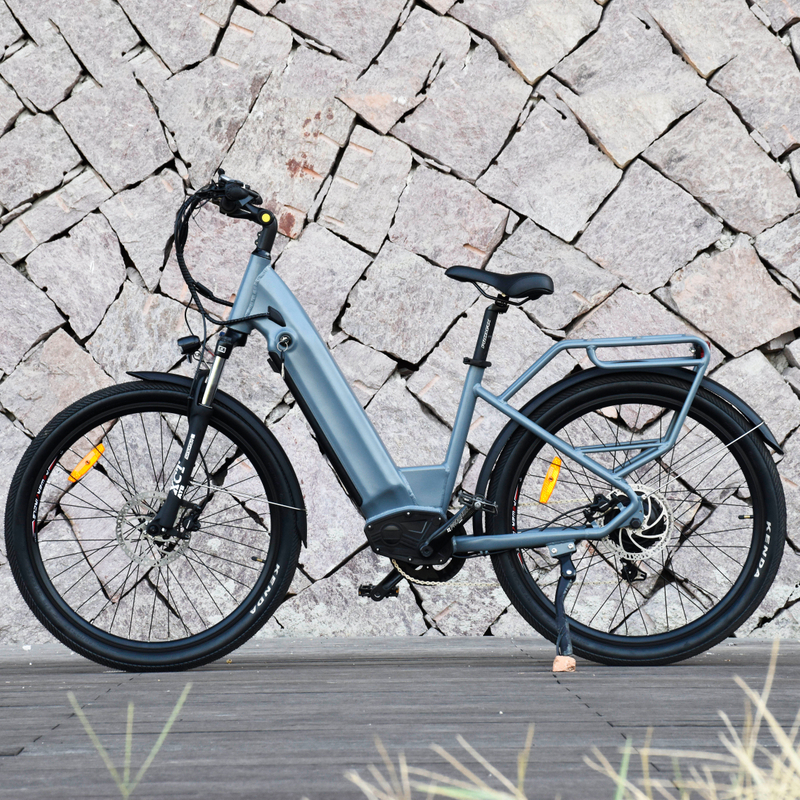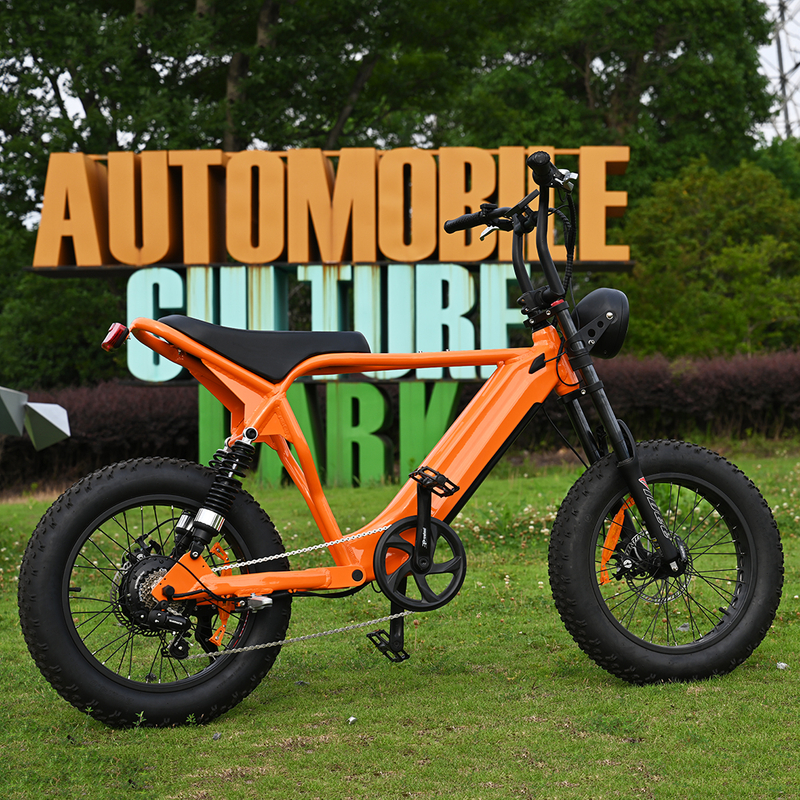Views: 0 Author: Site Editor Publish Time: 2025-04-25 Origin: Site









Electric mountain bikes (commonly referred to as electric mountain bike or e-MTB) are rapidly transforming the way outdoor enthusiasts explore nature. Combining traditional cycling with powerful electric motors, these bikes offer a fresh dimension to mountain biking. For beginners and seasoned riders alike, understanding what an electric mountain bike is, how it works, and what benefits it offers is essential.
An electric mountain bike is a bicycle designed for off-road use, equipped with an integrated electric motor to assist pedaling. This pedal-assist technology doesn't replace human effort but amplifies it. Riders still engage physically, but the electric motor helps them conquer steep inclines, rugged trails, and long distances with greater ease.
They feature knobby tires and reinforced frames.
Suspension systems are enhanced for absorbing shocks.
Motors and batteries are optimized for trail demands.
At the core of an electric mountain bike is a battery-powered motor, typically placed near the crank (mid-drive) or the rear hub. Sensors detect pedaling activity and deliver proportional power assistance. Most modern e-MTBs feature adjustable levels of assistance—from eco to turbo—giving riders control over battery usage and effort.
Motor: Delivers power to support your ride.
Battery: Usually lithium-ion; determines how far you can go.
Controller: Interface to adjust power levels.
Sensor System: Detects torque and cadence.
Electric mountain bikes open up new possibilities for cyclists of all skill levels:
Extended Range: Go further without fatigue.
Climbing Power: Tackle steep, technical terrain.
Time Efficiency: Cover more ground in less time.
Inclusive Experience: Perfect for group rides with varying fitness levels.
They’re not just a trend—they’re reshaping the entire mountain biking landscape.
With advances in battery technology and motor efficiency, electric mountain bike models are becoming lighter, more responsive, and more powerful. Emerging trends include:
Longer Battery Life: Up to 100km on a single charge.
Integrated Frames: Hidden batteries for sleek aesthetics.
Smart Features: GPS integration, ride tracking, and app controls.
Modular Systems: Swappable battery packs for multi-day adventures.

An electric mountain bike can navigate diverse terrains:
Forest trails
Mountain passes
Gravel roads
Technical singletrack
It empowers riders to push boundaries with confidence, thanks to its durable build and power support.
While electric mountain bikes are generally safe, there are best practices to follow:
Ride within your skill level. Enhanced speed can be deceptive.
Wear protective gear, especially a helmet and gloves.
Understand braking distances. Extra speed and weight affect stopping power.
Maintain your e-MTB regularly to ensure optimal performance.
More riders are choosing electric mountain bikes as a sustainable alternative to motorized off-road vehicles. They produce no emissions and leave a smaller trail footprint. With responsible use, e-MTBs align with modern environmental values.

Zhejiang Eshion Technology Co.,Ltd offers expertly engineered electric mountain bikes tailored for both recreational and rugged use. Their models feature:
High-torque motors for superior uphill assistance.
Integrated lithium-ion batteries that support extended adventures.
Robust suspension and shock absorption systems for comfort.
Precision gearing and lightweight frames for control and agility.
With a dedication to quality, safety, and rider satisfaction, Eshion’s electric mountain bikes represent a harmony between innovation and outdoor passion.
Selecting the perfect electric mountain bike (e-MTB) requires balancing performance, comfort, and personal riding preferences. First, prioritize the motor power, measured in watts (W), as it directly impacts climbing ability and acceleration. Entry-level models typically offer 250W–500W motors, ideal for casual trail riding, while high-torque 750W–1000W systems excel on steep technical terrain. Pair this with a battery capacity (watt-hours, Wh) that matches your riding habits: A 500Wh battery provides 40–80 km of range depending on terrain and assist level, whereas 700Wh+ batteries suit all-day adventures. Next, evaluate the frame geometry: Aggressive riders may prefer a slack head angle (65°–66°) and long wheelbase for stability at high speeds, while recreational riders might opt for a steeper angle (67°–69°) for nimble handling.
The suspension system is equally critical. Hardtail bikes (front suspension only) reduce weight and cost, making them ideal for smooth trails and cross-country efficiency. Full-suspension designs, with rear shock absorbers, absorb impacts on rocky descents but add complexity and price. Wheel size also shapes the ride: 27.5-inch wheels offer quick maneuverability for tight trails, while 29-inch variants roll over obstacles more smoothly. Before purchasing, test multiple bikes on varied terrain and consult certified dealers to assess component quality (e.g., Shimano vs. Bosch motors) and warranty coverage. Remember to factor in accessories like dropper posts for steep descents or integrated lights for twilight rides.
Proper care ensures your e-MTB delivers reliable performance and extends its lifespan. Start by managing the battery: Avoid draining it below 20% to prevent cell degradation, and store it in a cool, dry place (10°C–25°C) when not in use. Use only the manufacturer-provided charger, as third-party units may damage the battery management system. After rides, clean the bike thoroughly using a soft brush and biodegradable cleaner, focusing on the drivetrain, motor housing, and suspension seals. Never use high-pressure hoses, as water can penetrate electrical components.
Regular mechanical checks are vital. Monitor tire pressure weekly—higher PSI (30–35) reduces rolling resistance on hardpack, while lower pressure (20–25 PSI) enhances grip on loose surfaces. Inspect brake pads for wear; sintered metal pads last longer on muddy trails, while resin pads offer quieter performance. Lubricate the chain after cleaning, and check motor firmware updates through the brand’s app—these often optimize power delivery or fix bugs. For complex issues like suspension tuning or motor diagnostics, schedule annual service with an e-bike specialist. Lastly, protect your investment with a waterproof cover during transport and consider anti-theft GPS trackers for urban commuting. By adopting these practices, you’ll maximize both safety and riding enjoyment.
Q1: Are electric mountain bikes good for beginners?
Yes. The pedal-assist feature helps reduce the intimidation of steep or technical trails.
Q2: How long does the battery last?
Most electric mountain bike batteries last between 30–100 km per charge, depending on terrain, weight, and assistance level.
Q3: Can I ride in the rain or on wet trails?
Yes, but always check your e-MTB's IP rating and avoid deep water crossings.
Q4: Is riding an electric mountain bike cheating?
Absolutely not. You still pedal and navigate challenging terrain—just with a boost.
Q5: Are there trails where electric mountain bikes are not allowed?
Some protected natural areas restrict motorized access. Always check local trail regulations.
Q6: How do I improve battery longevity?
Store it at moderate temperatures, avoid deep discharges, and charge after every ride.
Electric mountain bikes are not just a fad—they are the future of mountain biking. By combining endurance, power, and smart technology, they empower riders to go further, faster, and freer. With options like those from Zhejiang Eshion Technology Co.,Ltd, riders are equipped with the latest innovations and unmatched performance.
Explore the mountains with confidence. Discover your perfect ride with Eshion at eshionbike.com.